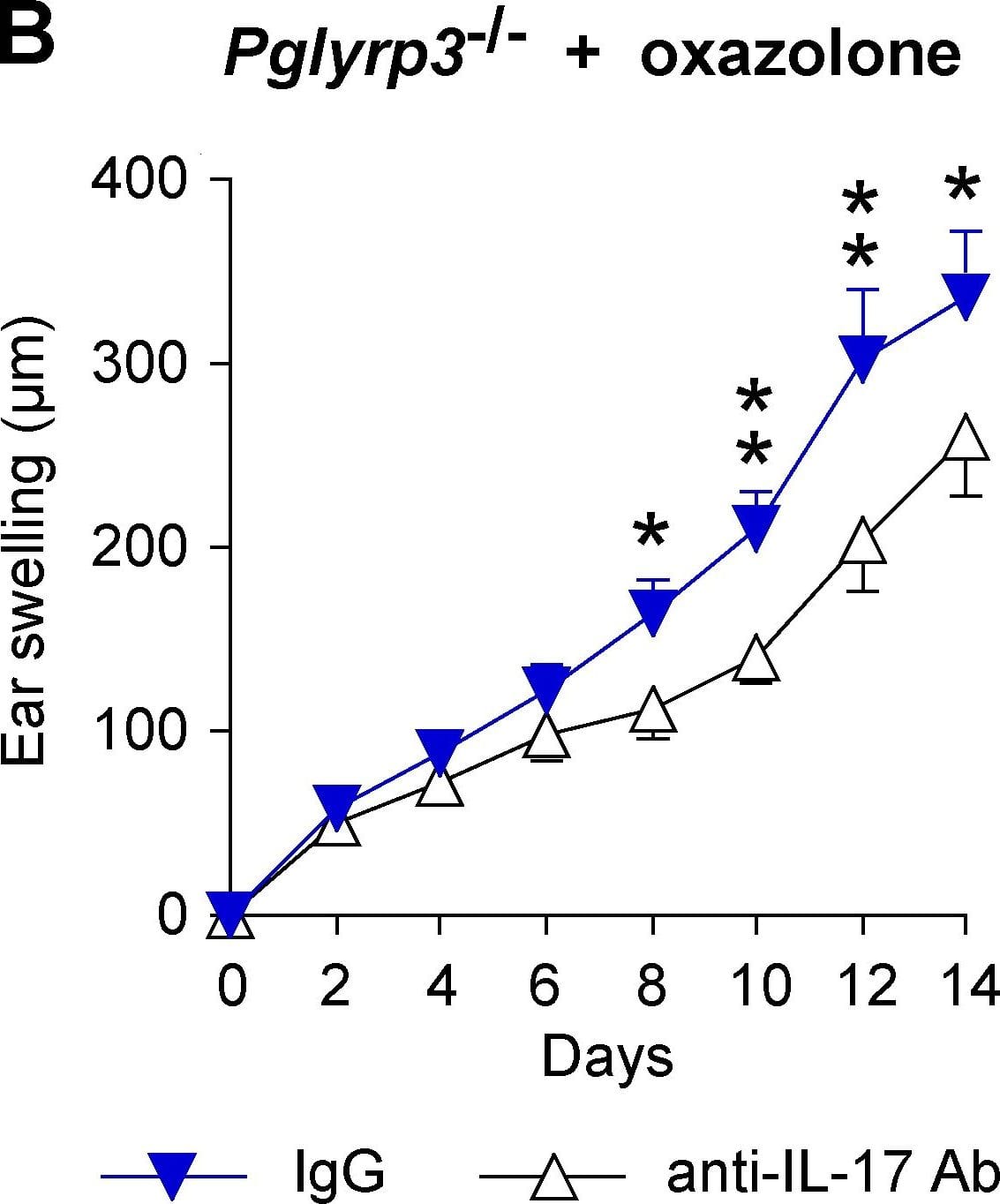Mouse IL-17/IL-17A Antibody
R&D Systems, part of Bio-Techne | Catalog # MAB421

Key Product Details
Validated by
Species Reactivity
Validated:
Cited:
Applications
Validated:
Cited:
Label
Antibody Source
Product Specifications
Immunogen
Thr22-Ala158
Accession # Q62386
Specificity
Clonality
Host
Isotype
Endotoxin Level
Scientific Data Images for Mouse IL-17/IL-17A Antibody
Detection of Recombinant Mouse IL‑17/IL‑17A by Western Blot.
Western blot shows 25 ng of Recombinant Mouse IL-17/ IL-17A (Catalog # 421-ML), Recombinant Human IL-17/IL-17A (Catalog # 317-ILB), Recombinant Rat IL-17/IL-17A (Catalog # 8410-IL), and Recombinant Mouse IL-17F (Catalog # 2057-IL). PVDF Membrane was probed with 1 µg/mL of Rat Anti-Mouse IL-17/ IL-17A Monoclonal Antibody (Catalog # MAB421) followed by HRP-conjugated Anti-Rat IgG Secondary Antibody (Catalog # HAF005). A specific band was detected for IL-17/IL-17A at approximately 15 kDa (as indicated). This experiment was conducted under reducing conditions and using Immunoblot Buffer Group 3.IL‑6 Secretion Induced by IL‑17 and Neutralization by Mouse IL‑17 Antibody.
Recombinant Mouse IL-17 (Catalog # 421-ML) stimulates IL-6 secretion in the NIH-3T3 mouse embryonic fibroblast cell line in a dose-dependent manner (orange line), as measured by the Mouse IL-6 Quantikine ELISA Kit (Catalog # M6000B). IL-6 secretion elicited by Recombinant Mouse IL-17 (10 ng/mL) is neutralized (green line) by increasing concentrations of Rat Anti-Mouse IL-17 Monoclonal Antibody (Catalog # MAB421). The ND50 is typically 0.05-0.15 µg/mL.Detection of Mouse IL-17/IL-17A by In vivo assay
Ear histology in WT and Pglyrp-deficient mice in atopic dermatitis and contact dermatitis models of skin inflammation.(A) Oxazolone model of atopic dermatitis: sensitization and 10 applications of oxazolone to the ears every other day induced acanthosis (Ac), parakeratosis (Pk), marked thickening of the sub-epidermal layer with spongiosis (Sp) and dense cellular infiltrates of primarily mononuclear and some polymorphonuclear cells (high magnification insets), that were all highly prominent in Pglyrp3−/− mice and Pglyrp4−/− mice and much less severe in WT mice. (B) Oxazolone model of contact dermatitis: sensitization and a single application of oxazolone to the ears induced strong inflammatory response in WT mice with marked spongiosis of the sub-epidermal layer (Sp) and cellular infiltrates of epidermal and sub-epidermal layers, composed of mononuclear and polymorphonuclear cells; Pglyrp1−/− and Pglyrp1−/−Pglyrp2−/− mice still had cellular infiltrates, but had substantially reduced swelling, compared to WT mice, mostly due to reduced edema. H&E stained cross-sections; bar = 200 µm for all panels, except high magnification insets (the magnified areas are shown by rectangles). Image collected and cropped by CiteAb from the following publication (https://pubmed.ncbi.nlm.nih.gov/21949809), licensed under a CC-BY license. Not internally tested by R&D Systems.Applications for Mouse IL-17/IL-17A Antibody
Western Blot
Sample: Recombinant Mouse IL-17 (Catalog # 421-ML)
Neutralization
Reviewed Applications
Read 2 reviews rated 5 using MAB421 in the following applications:
Formulation, Preparation, and Storage
Purification
Reconstitution
Formulation
Shipping
Stability & Storage
- 12 months from date of receipt, -20 to -70 °C as supplied.
- 1 month, 2 to 8 °C under sterile conditions after reconstitution.
- 6 months, -20 to -70 °C under sterile conditions after reconstitution.
Background: IL-17/IL-17A
Interleukin 17 (also known as CTLA-8) is a T cell-expressed pleiotropic cytokine that exhibits a high degree of homology to a protein encoded by the ORF13 gene of herpes virus Saimiri. cDNA clones encoding IL-17 have been isolated from activated rat, mouse and human T cells. Mouse IL-17 cDNA encodes a 158 amino acid (aa) residue precursor protein with a 21 amino acid residue signal peptide that is cleaved to yield the 137 aa residue mature IL-17. Both recombinant and natural IL-17 have been shown to exist as disulfide linked homodimers. At the amino acid level, mIL-17 shows 57% and 87% sequence identity with herpesvirus and rat IL-17, respectively. An IL-17 specific mouse cell surface receptor (IL-17 R) has been cloned. While the expression of IL-17 mRNA is restricted to activated alpha beta TCR+CD4-CD8-T cells, the expression of mIL-17 R mRNA has been detected in virtually all cells and tissues tested. IL-17 exhibits multiple biological activities on a variety of cells including: the induction of IL-6 and IL-8 production in fibroblasts; the enhancement of surface expression of ICAM-1 in fibroblasts; activation of NF-kappa B and costimulation of T cell proliferation.
References
- Kennedy, J. et al. (1996) J. Interferon Cytokine Res. 16:611.
- Yao, Z. et al. (1995) J. Immunol. 155:5483.
- Yao, Z. et al. (1995) Immunity 3:811.
- Rouvier, E. et al. (1993) J. Immunol. 150:5445.
Long Name
Alternate Names
Entrez Gene IDs
Gene Symbol
UniProt
Additional IL-17/IL-17A Products
Product Documents for Mouse IL-17/IL-17A Antibody
Product Specific Notices for Mouse IL-17/IL-17A Antibody
For research use only





